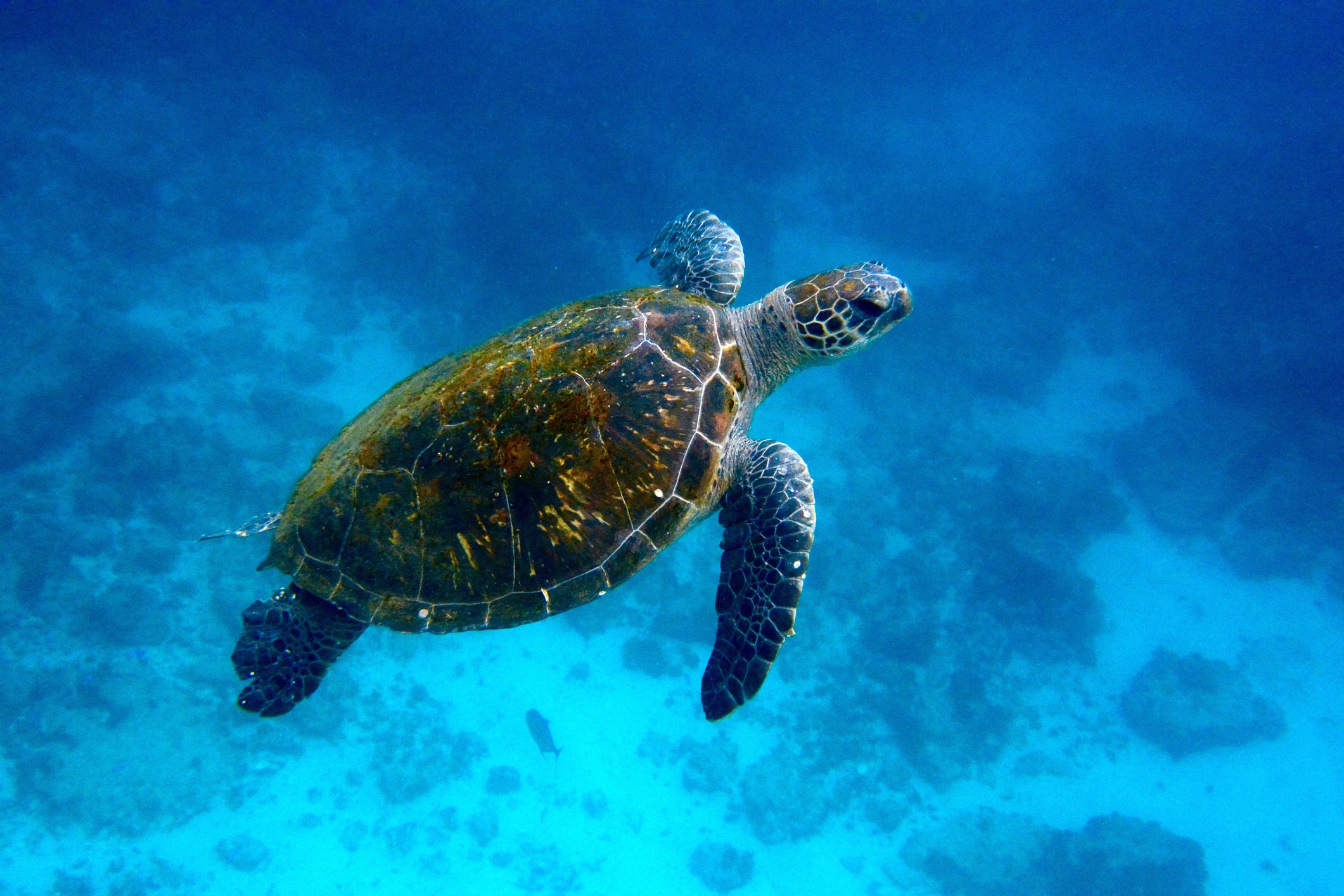Snorkelling with sea turtles is one of the most incredible natural experiences that you can have, but its important to do it in safe and ethical way, so I’ve put together this guide for you to cover these areas:
- What do I need to know about sea turtles?
- How to snorkel safely with sea turtles
- The ethical rules of snorkelling with turtles
- My experience of snorkelling with turtles
- Can you see turtles at night?
- How do you photograph turtles underwater?
- Places in the world where you can find turtles
This is my complete guide to snorkelling (or diving) safely and sustainably with sea turtles

*This post may contain affiliate links*
What do I need to know about sea turtles?
There are 7 species of sea turtle – green, Kemp’s Ridley, hawksbill, leatherback, loggerhead, Olive Ridley, and flatback. I’ve most commonly seen green and Olive Ridleys, but it’s a great personal challenge to see them all!
These incredible animals have been around for 150 million years, making them one of the world’s oldest sea creatures. At present, six of the turtle species are classified as threatened or endangered, this is due to poaching, habitat destruction, climate change, fishing accidents amongst other environmental problems. The good news is that conservation work is being done to increase their numbers around the world so that they can be here for years to come.
How to snorkel safely with sea turtles
When you’re looking for turtles, remember that they eat jellyfish. Unfortunately, this means that the stingers can remain in the water and they can still sting you – trust me! If you are concerned about jellyfish then consider purchasing a wetsuit. Follow these tips for avoiding jellyfish as well as what to do if you do get minor stings. I got stung when snorkelling with turtles which was a pain (literally). If there are dangerous jellies around then don’t get in the water.
Always remember to look out for boats and don’t crowd marine life. For your own safety, don’t get in the water if it’s too choppy and use a lifejacket if you’re not a strong swimmer.
RECOMMENDED SNORKEL:
The ethical rules of snorkelling with turtles
Be sure to adhere to the snorkelling code of conduct in order to protect the reef, do not touch any coral or marine life, apply reef-safe sunscreen 30 minutes before going into the water and don’t take anything from the ocean, unless it’s trash.
Read more of my sustainable snorkelling tips and for reef-safe sunscreen recommendations here.
Avoid using single-use plastics like bottles or straws as these can end up in the sea, causing big problems for marine life, especially in places without a robust waste disposal system. Try these 15 bamboo swaps to help you go zero-waste in zero time!
My experience of snorkelling with turtles
I’ve seen sea turtles in a number of places while on my travels, sometimes I haven’t even had to get in the water to see them! as I saw a green turtle from a jetty in the Maldives, Olive Ridley turtles having sex from a whale watching boat in Sri Lanka and I saw turtles laying eggs on Tortuguero Beach in Costa Rica, so you don’t have to get wet if you don’t want to.
Indonesia has been my best spot for turtle spotting and I saw turtles while snorkelling with manta rays at Manta Point in Nusa Lembongan. My best day was when I saw several green turtles off the Gili Islands in Lombok. It was great that there were so many turtles there, but there were a lot of tourists around so its vital not to get too close.
Read about the 21 fish species you’ll see when snorkelling or diving in Bali or Lombok.
Can you see turtles at night?
To see turtles at night, you need to go on a night dive but make sure you go with a good provider and be careful. If you do go you might even get to a turtle having a snooze on top of a reef!
Remember that the ocean can be dangerous at night, there could be currents, predators like jellyfish or sharks around as well as the chance of bumping into sharp rocks or marine litter like fish hooks. Don’t go anywhere without your torch and your buddy.
Read my full guide to snorkelling with bioluminescent plankton at nighttime.
How do you photograph turtles underwater?
If you want to photograph turtles, then it’s easier to do in shallow waters during in the daytime. Try and get them in the natural sunlight near the surface as you’ll need to use a strobe if you’re diving deeper.
A good place to find turtles sitting still is when they’re feeding on sponges on the reef. If the turtle is swimming, don’t chase it as it will turn around to avoid you which would ruin your shot. Try to distinguish your turtle from its surroundings by shooting upwards, which lets the light into your camera.
When you’re on the reef, look for interesting behaviour like when smaller creatures clean and feed from the turtle’s shell. If you’re snorkelling then you can get a decent shot by using a GoPro in underwater housing.
Read more about photographing sea turtles.
Places in the world where you can commonly see sea turtles:
- Indonesia
- Southern Thailand
- Malaysia
- Hawaii
- Philippines
- Costa Rica
- Belize
- Mexico
So if you’re planning on visiting any of these places, find out whether you’ll be passing a turtle bay along the way!
Check the reviews before your travel:
Have you ever seen sea turtles in action? If so, whereabouts in the world did you see them? Share your turtle stories in the comments below!
Pin this for later: